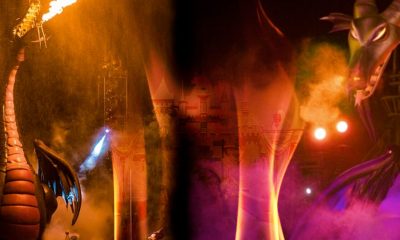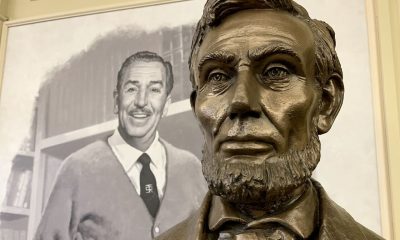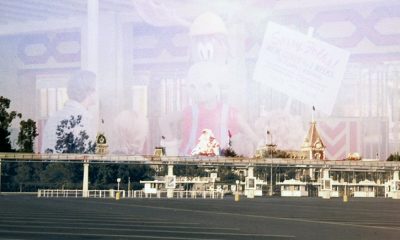History
Original Disneyland Lessee: Van Camp Seafood and The Chicken of the Sea Pirate Ship Restaurant
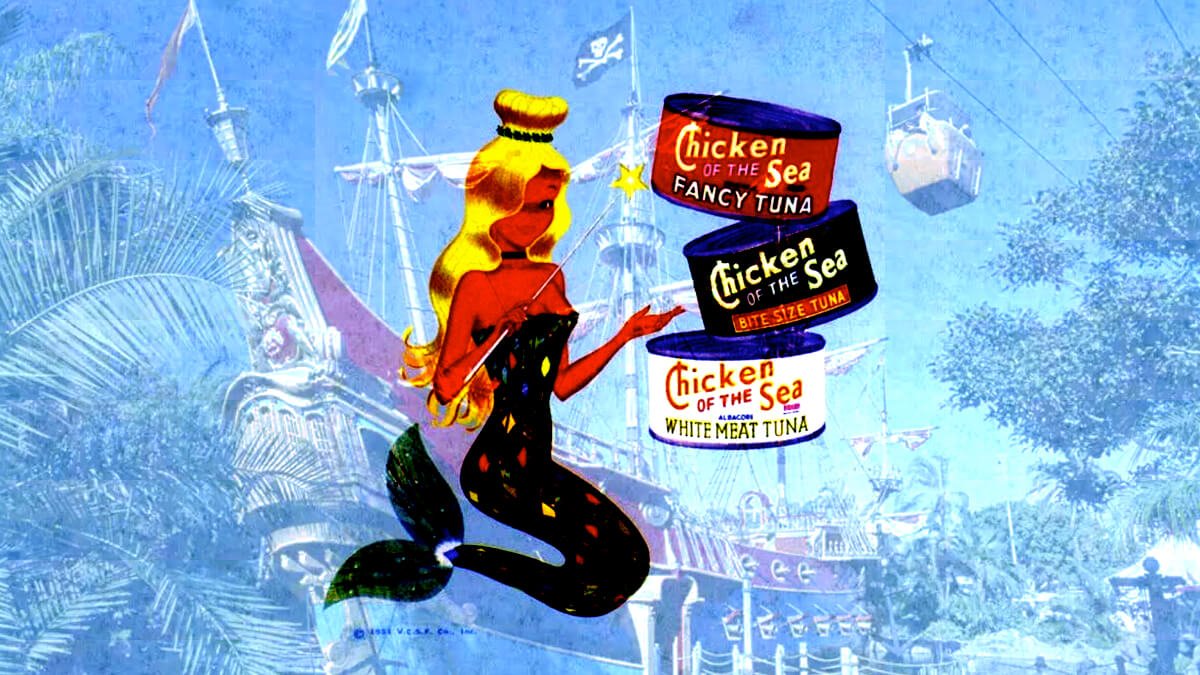
Since we’ve gotten such strong reaction to previous “Disney Dishes” where Len & I talked about original Disneyland lessees like Swift Meats (who sponsored the Red Wagon Inn at the Park, which was the precursor to Disneyland’s Plaza Inn Restaurants) and Monsanto (who sponsor the Hall of Chemistry AND the House of the Future), I thought that we’d take a moment to shine a spotlight on another company that helped make up the original 48 lessees at Disneyland.
Original Disneyland Lessees
When Disneyland first opened in July of 1955 – the Park had 48 lessees. A number of those were short-lived outfits like Hollywood Maxwell’s Intimate Apparel Shop and the BlueBird Shoes for Children Shop that came & went within the first few years that Disneyland was operational. By 1966 / 1967, the number of lessees that the Park had had shrunk down by nearly a third. To 33, to be exact.
That’s an interesting number – 33.
Seems significant for some reason. Can’t place why, though.
Van Camp Seafood Company
Some 67 years ago (August 29, 1955, to be exact), the Chicken of the Sea Pirate Ship Restaurant (the quick service restaurant that Van Camp Seafood sponsored at the Park) first opened for business.
Kind of appropriate that Van Camp Seafood came to sponsor a restaurant at Disneyland. After all, this fish canning company actually got its start some 95 miles to the south of Anaheim in San Diego, California back in May of 1914 – founded by Frank Van Camp & his son Gilbert.
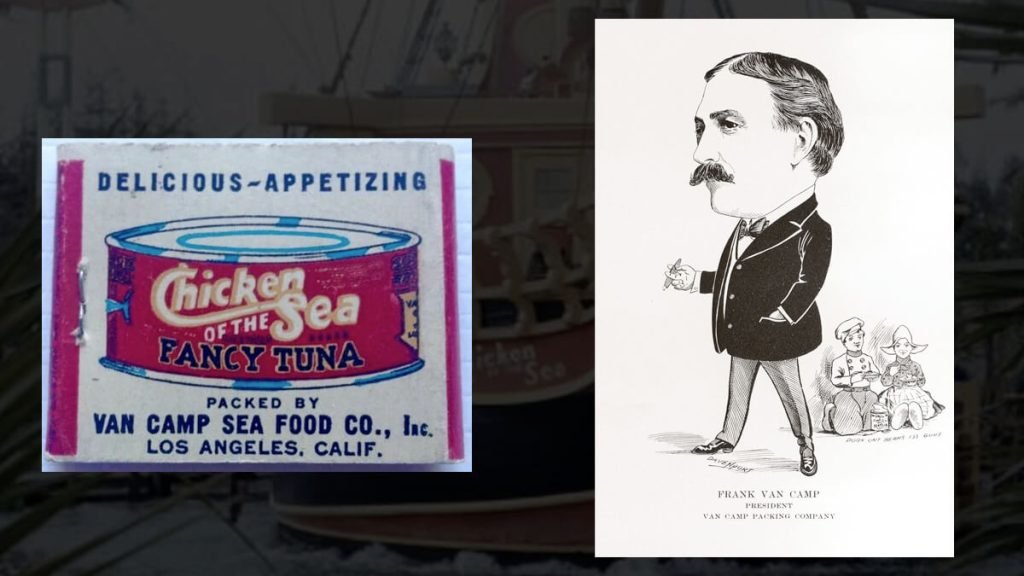
And as for that “Chicken of the Sea” thing … That was a bit of branding Van Camp embraced back in 1930. You see, the type of tuna that they initially specialized in canning (i.e., white albacore) was acclaimed for its mild flavor & color.
“Tastes like chicken” = “Chicken of the Sea.”
By 1952, Van Camp Seafood further refined their brand by introducing the Company’s icon: Catalina the Mermaid.
Interesting side note: If Catalina the Mermaid looks kind of familiar to all you Trekkies out there … Well, there’s a good reason for that. Grace Lee Whitney – who played Yeoman Rand on the original “Star Trek” television series – was actually the inspiration for Van Camp Seafood’s corporate icon.
Peter Pan & Mermaid Lagoon
We jump ahead now to February of 1953, which is when Walt Disney Studios releases its feature-length animated version of “Peter Pan” (which is based on J.M. Barrie’s 1904 play about “The Boy Who Wouldn’t Grow Up”). This animated feature includes a scene where Peter takes Wendy Darling to Mermaid Lagoon. Where those mermaids then try to drown Wendy. I guess Catalina hangs out with a rough crowd.
Jump ahead to 1954. Walt is looking to lock in sponsors for his new family fun park. And Disney’s animated version of “Peter Pan” is still very front of mind. Which is why – when Disney representatives reach out to Van Camp Seafoods to ask if this fish canning company would be willing to sponsor some sort of attraction at Disneyland – Frank & his son Gilbert are interested.
The Van Camps do have some conditions, though. As part of whatever their Company sponsors at Disneyland, this shop, restaurant or attraction has to prominently feature Catalina the Mermaid, the Chicken of the Sea icon.
The folks at Disney go away for a bit to ponder this proposition … and then eventually come back with a proposal for the Van Camp family. What about a restaurant that’s also an attraction? As in: The Chicken of the Sea Pirate Ship Restaurant.
The Chicken of the Sea Pirate Ship Restaurant
This massive structure – we’re talking 79 feet long and 80 feet tall (That includes the ship’s three masts. Which were each 60 feet tall) – was to be a recreation of the Jolly Roger, Captain Hook’s ship from Disney’s animated version of “Peter Pan.” Guests would have the opportunity to board this vessel and explore the upper deck. Below decks, there’d be a quick service restaurant that only served food items that could be made with Van Camp Seafood products. We’re talking:
- A Tuna Sandwich
- A Tuna Burger
- A Tuna Pie served in a Pastry Shell
- A Tuna Boat Salad
- A Tuna Clipper Salad (a clipper is a slightly bigger boat)
- Shrimp Cocktail (Van Camp Seafood also sold canned shrimp)
- and Fruit Tart with Whipped Cream (which must have had a little tuna in it)
Reminds me of that Monty Python bit. “It’s only got some spam in it. Spam, spam, spam, span, baked beans & spam.”)
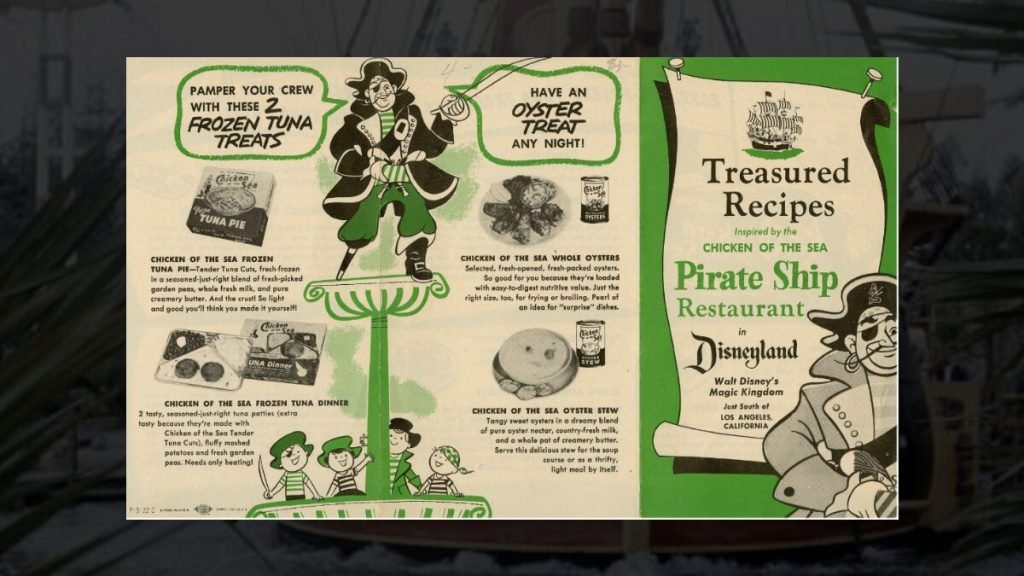
Frank & Gilbert Van Camp loved this idea. Even so, it took a while to Van Cap Seafood & Walt Disney Productions to negotiate the final contract. Not to mention draw up the construction blueprints for this Fantasyland restaurant / attraction. I’ve seen a set of these blueprints that Fred Stoos (he was one of the original construction coordinators on the Disneyland project) drew up that are dated May 7, 1955.
Building the Jolly Roger
That’s basically 10 weeks before Disneyland first opens to the public. So as soon as those blueprints were signed off on, they immediately began building the Jolly Roger out behind the park’s lumber mill. Which – after the Park was completed – this building would then become the Main Street Opera House.
The ship itself was built out of Douglas Fir. And as for this pirate ship’s trim, that was genuine mahogany which had been shipped in from Honduras.
Now remember that condition that Frank & Gilbert Van Camp insisted upon? That Disneyland’s Chicken of the Sea Pirate Ship Restaurant had to feature their company’s icon – Catalina the Mermaid – in some way?
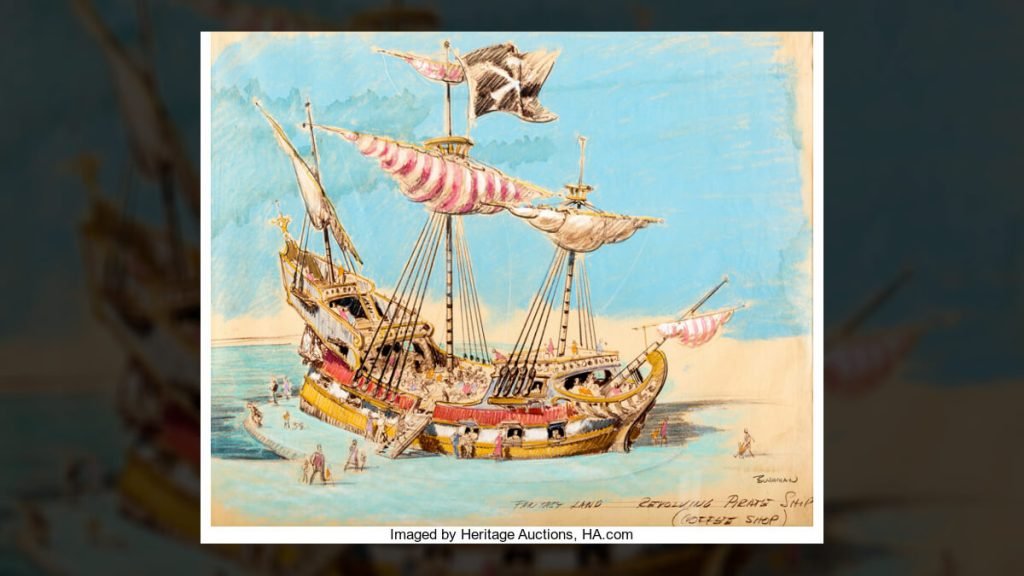
Credit: Comics.ha
Catalina the Mermaid – Figurehead
Disney honored this sponsorship condition by making Catalina the Jolly Roger’s figurehead. Chris Mueller (who sculpted all of the animals that Guests saw on Disneyland’s “Jungle Cruise.” Not to mention the giant squid in Disney Studio’s “20,000 Leagues Under the Sea” film. In addition to creating “The Creature from the Black Lagoon” for Universal Pictures’ 1954 film of the same name) not only created that beautiful 6-foot-tall piece, Mueller also sculpted an enormous piece for this ship’s stern. Which replicated the way Catalina the Mermaid was depicted on each can of “Chicken of the Sea” tuna. With Catalina seated atop her shell throne which is then borne on the back of a giant sea turtle. Beautiful piece.
The Flying Jolly Roger
Remember how this pirate ship restaurant was quickly being built backstage at Disneyland out behind that park’s lumber mill? When it came time for this building to finally be moved into place over in Fantasyland … Well, remember how the Jolly Roger flew in Disneyland’s animated version of “Peter Pan” ? This structure flew as well. It was lifted by a construction crane over all of those still-under-construction Tomorrowland buildings and then dropped into place behind the Park’s Mad Tea Party flat ride.
Painting and Camera Tricks
The only problem was … The night before that “Dateline: Disneyland” special aired live on ABC, Walt realized that he was running out of time & money. And the Chicken of the Sea Pirate Ship Restaurant (while it was now in its proper place in the Park) was still unpainted. And if the Van Camp family saw the restaurant / attraction that they’d paid for show up on live television looking like that, Frank & Gilbert would be furious.
Walt’s solution to this not-enough-time / not-enough-money problem was kind of ingenious. He only had his painters paint the side of the Chicken of the Sea Pirate Ship Restaurant that faced into the Park (i.e. the side that would appear on camera). Walt then had a bunch of Disney Studios employees placed on deck. When the cameras came on, these folks rushed to the rail and then wave frantically towards the camera. That way, no one would notice that the props or rigging on this ship weren’t in place either.
This trick worked. The Jolly Roger looked great on camera. And just so you know: It would take another six weeks of hard work after the “Dateline: Disneyland” TV special aired before the Chicken of the Sea Pirate Ship Restaurant was finally ready to serve food / begin entertaining Disneyland Guests.
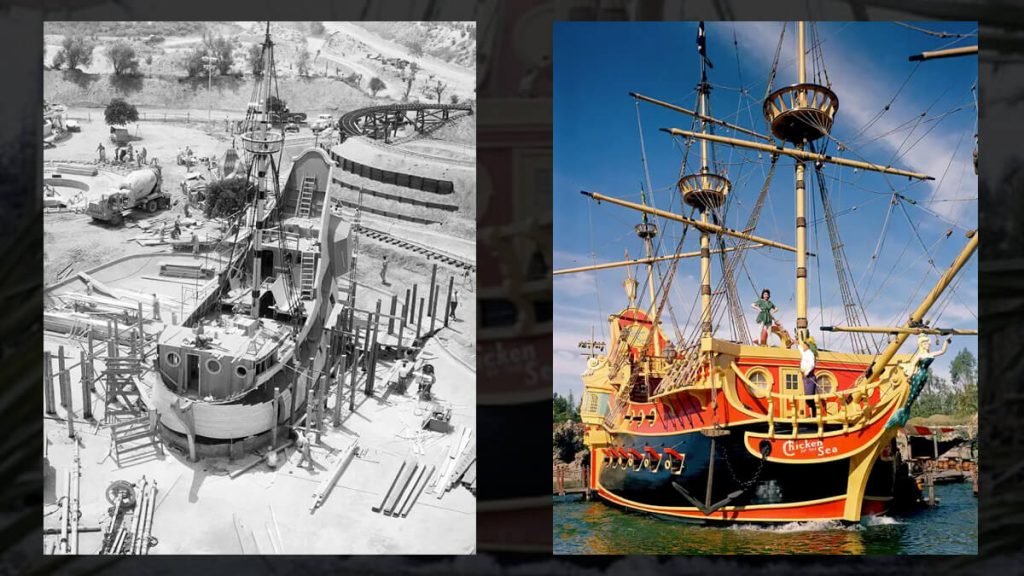
Popularity and Expansion of The Chicken of the Sea Pirate Ship
This eatery became so popular with Disneyland Guests that … Well, after Walt finally wrestled ABC’s partial ownership of the Park away from that broadcast company in June of 1960 (He had to pay that company $7.5 million for its one third ownership of the Park) … One of the very first thing Disney did was to create a secondary seating area for this Fantasyland eatery.
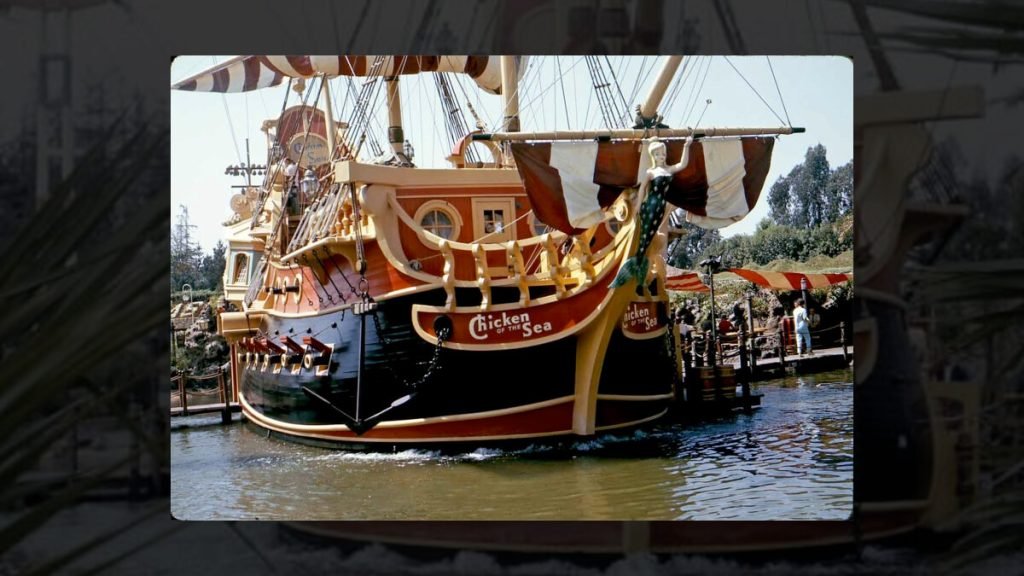
Here’s how that expansion project was described in the October – November 1960 issue of the “Disneylander” (i.e., the park’s employee newsletter back then):
This article’s headline read: “Pirate Ship To Have New And Exotic Setting”
And here’s a quote from this piece:
“By the time you read this, you’ll be aware that the Chicken of the Sea Pirate Ship is closed for extensive rehab. It is scheduled to reopen about December 15th. Isolated by craggy cliffs covered with lush tropical foliage will be ‘Pirate’s Cove,’ where the Park’s well known Pirate Ship resides at anchor. WED designers have included in their plans the familiar landmark of Skull Rock from the Peter Pan story with three waterfalls cascading from rocky heights.”
Construction of Pirate’s Cove & Skull Rock actually took a little longer than expected. This Fantasyland addition wouldn’t open ‘til just before Christmas. December 23, 1960, to be exact.

Van Camp Seafood Partnership
The folks at Van Camp Seafood initially seemed very pleased with their association with Disneyland Park. They renewed their original sponsorship agreement with the Park in 1962 for another seven year-long lease. Unfortunately, in 1963, Frank & Gilbert sold their fish canning company to Ralston Purina. And when the sponsorship contract for the Chicken of the Sea Pirate Ship Restaurant came up for renewal in 1969, Ralston Purina opted out.
Captain Hook’s Galley
Disneyland management responded to this loss of sponsor by changing the name of this Fantasyland restaurant from The Chicken of the Sea Pirate Ship Restaurant to Captain Hook’s Galley. They also made minor tweaks to the ship’s figurehead and the giant stern piece so that the mermaids there no longer looked just like Catalina, Chicken of the Sea’s corporate icon.
Moving to New Fantasyland
We now jump ahead to the Fall of 1981. Work has just begun on Disneyland’s New Fantasyland. Which – when this side of the Park re-opens in the Summer of 1983 – will feature all-new versions of Disneyland’s classic dark rides like “Snow White’s Scary Adventures” & “Mr. Toad’s Wild Ride” featuring then-state-of-the-art effects like fiber optics & digital sound.
Among the changes that are in the works for this side of the Park is that the ship that houses Captain Hook’s Galley is once again going to be lifted by a crane. Only this time, it’s going to lifted over a 100 feet or so that this full-sized pirate ship could then became the finale of Disneyland’s Storybook Land Canal Boats ride. The canal boats – after floating by all of those miniaturized recreations of settings from famous Disney films – would now find themselves, in the final moments of this ride, right alongside of the Jolly Roger.
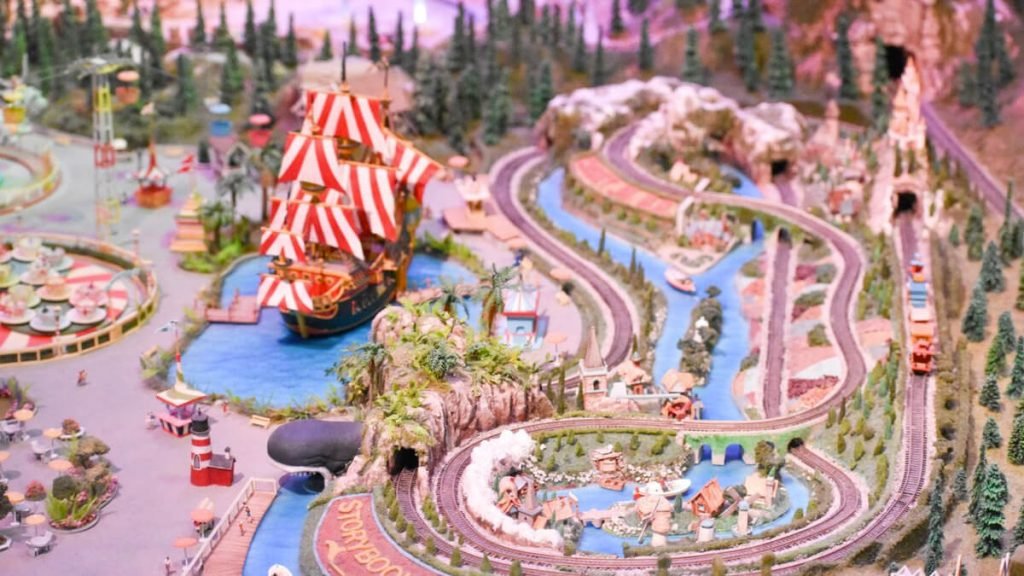
The Imagineers thinking here was … Well, Disneyland’s Storybook Land Canal Boats ride starts off with a big moment (the canal boat you’re riding in gets swallowed up by Monstro the whale from “Pinocchio”). It should then have a similarly big moment at the moment at the end. Besides – by moving the structure that previously housed Captain Hook’s Galley from the centerbackmost portion of Fantasyland over to the eastern edge of this land at Disneyland – this then opened some very valuable real estate right in the middle of one of the more popular / most crowded corners of the Park.
So okay. So once this part of the Imagineers’ plans for a new Fantasyland at Disneyland was signed off on by Park Management … Phase One of Operation “The Jolly Roger Flies Again” was to first gently pry Chris Mueller’s now 26-year-old mermaid sculptures off of the bow & the stern of the Chicken of the Sea Pirate Ship Restaurant and then take them backstage to be restored. Then the pirate ship would be hoisted into its new location at the edge of Small World Plaza. Whereupon the load / unload area for the Storybook Land Canal Boats ride would be expanded to create a brand-new lagoon space that this pirate ship could be anchored in.
Just so you know: I’ve never been able to confirm that Skull Rock was to have then be recreated in this new location. The insinuation here was that – once both phases of the New Fantasyland project were complete (Phase One was to be ready for the Late Spring of 1983. While Phase Two – which involved the revamped version of the “Alice in Wonderland” dark ride, the relocation of Disneyland’s “Mad Tea Party” dark ride and the Mad Hatter’s Hat Shop – would open in the Spring of 1984) — the Imagineers would then attempt to ram through the creation of a second version of Skull Rock. Which would then help hide where the maintenance dock for the Storybook Land Canal Boats would be taken every night.
I have also been told that the below-decks area (which was initially supposed to be closed off to Guests once the Jolly Roger was flown into its new location of the Eastern edge of Small World Plaza) was to have then been completely renovated. And that – for the Summer of 1985 (Just in time for Disneyland’s 30th birthday celebration) what had previously been a quick service restaurant would then be turned into a pirate-themed juice bar. Which was kind of a cool idea.
Problems with the Move & Demolition of the Jolly Roger
This was the plan anyway. Unfortunately, after those two mermaid pieces were carefully pried off of the bow & the stern of Captain Hook’s Galley, the forklift that was taking both of these pieces backstage made a sudden stop. The mermaid pieces then fell off and shattered to smithereens.
Worse that that: When the New Fantasyland construction crew went to go arrange the harnesses that were necessary to hoist this 26-year-old pirate ship high in the air over to its new location, they then discovered that the old Chicken of the Sea Pirate Ship Restaurant (which — remember – had originally built out of Douglas Fir outside of Disneyland’s old lumber mill and then been trimmed with genuine Honduran mahogany) was now riddled with termites. Long story short: This structure would have immediately crumbled into pieces as soon as that construction crane starts to pull on those harnesses.

As a direct result, the Chicken of the Sea Pirate Ship Restaurant was left at anchor right where it was until a demolition team could come along and pull this ship-shaped structure down. While they were at it, this demolition team also destroyed one of Disneyland’s favorite photo spots (Skull Island Cove). In its place today, you’ll now find Disneyland’s relocated Dumbo the Flying Elephant ride.
Which – of course – makes us OG Disneyland fans sad. I mean, that’s something that Walt put in place and then plussed. But it’s worth noting that the Jolly Roger — as well as Pirate Cove & Skull Rock — do live on. Only at a different Disney theme park.
Adventure Isle at Disneyland Paris
When the Imagineers opted to build Adventure Isle at Disneyland Paris in the early 1990s, they included a full-sized pirate ship that was then placed at anchor in front of a large-ish version of Skull Rock. And inside of this pirate ship, you’ll find yet another Captain Hook’s Galley. This one’s a counter-service restaurant, though. Not a pirate-themed juice bar.
Disneyland Tuna Burger and Fruit Tart with Whipped Cream
Just so you know: If you’re a Disneyland completist and wonder what it was like to actually dine at the Chicken of the Sea Pirate Ship Restaurant, if you Google “Disneyland Tuna Burger,” you can find a number of recipes online that will then allow you to replicate this signature item from the menu of this now-gone-for-nearly-40-years restaurant.
Me personally, given that whole everything-served-here-must-make-use-of-items-that-Van-Camp-Seafood-makes-or-sells condition, I still have to wonder just how much tuna there was in that one dessert item the Chicken of the Sea Pirate Ship Restaurant sold. Which was the fruit tart with whipped cream.
This article is based on research for The Disney Dish Podcast “Episode 389”, published on August 29, 2022. The Disney Dish Podcast is part of the Jim Hill Media Podcast Network.
History
The Super Bowl & Disney: The Untold Story Behind ‘I’m Going to Disneyland!’

One of the highlights of the Super Bowl isn’t just the game itself—it’s the moment when the winning quarterback turns to the camera and exclaims, “I’m going to Disney World!” This now-iconic phrase has been a staple of post-game celebrations for decades. But where did this tradition begin? Surprisingly, it didn’t originate in a stadium but at a dinner table in 1987, in a conversation involving Michael Eisner, George Lucas, and aviation pioneers Dick Rutan and Jeana Yeager.

The Unlikely Beginning of a Marketing Sensation
To understand the origins of this campaign, we have to go back to December 1986, when the Rutan Voyager became the first aircraft to fly around the world without stopping or refueling. Pilots Dick Rutan and Jeana Yeager completed the nine-day journey on December 23, 1986, flying over 26,000 miles before landing at Edwards Air Force Base. Their historic achievement earned them national recognition, and just days later, President Ronald Reagan awarded them the Presidential Citizen Medal at the White House.
Meanwhile, Disney was gearing up for the grand opening of Star Tours at Disneyland, set for January 12, 1987. Following its usual playbook of associating major theme park attractions with real-world pioneers, Disney’s PR team invited astronauts Gordon Cooper and Deke Slayton to the launch event. But in a twist, they also invited Rutan and Yeager, who were still making headlines.
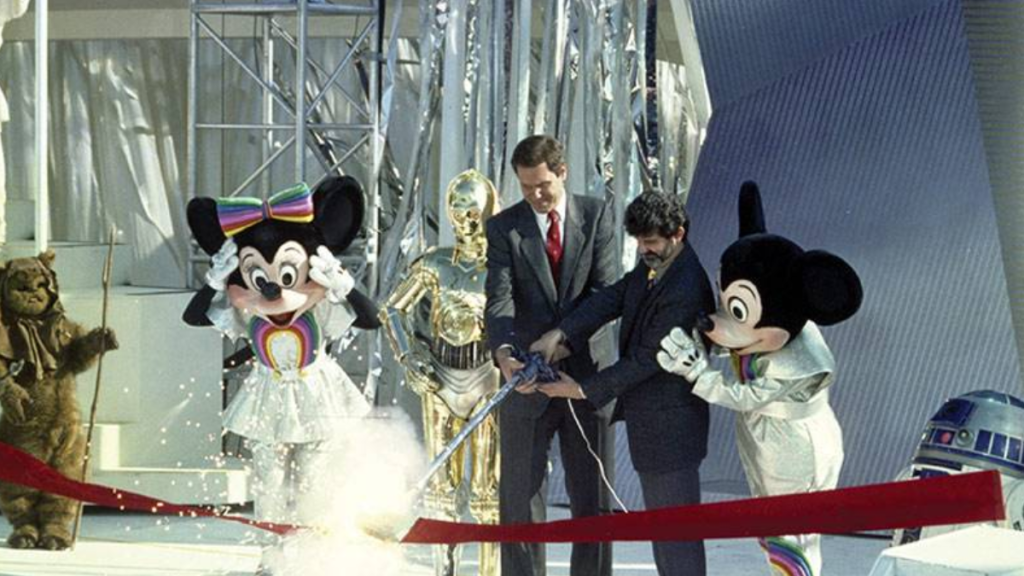
A Dinner Conversation That Changed Advertising Forever
After the Star Tours opening ceremony, a private dinner was held with Disney CEO Michael Eisner, George Lucas, and Eisner’s wife, Jane. During the meal, Eisner asked Rutan and Yeager, “You just made history. You traveled non-stop around the planet on a plane without ever refueling. How are you ever going to top that, career-wise? What are you two gonna do next?”
Without hesitation, Jeana Yeager replied, “Well, after being cramped inside that tiny plane for nine days, I’m just glad to be anywhere else. And even though you folks were nice enough to fly us here, invite us to your party… Well, as soon as we finish eating, I’m gonna go over to the Park and ride some rides. I’m going to Disneyland.”
Jane Eisner immediately recognized the power of Yeager’s statement. On the car ride home, she turned to Michael and said, “That’s a great slogan. I think you should use that to promote the theme parks.” Like many husbands, Michael initially dismissed the idea, but Jane persisted. Eventually, Eisner relented and pitched it to his team.
The Super Bowl Connection
With Super Bowl XXI just around the corner, Disney’s PR team saw an opportunity. The game was set for January 25, 1987, at the Rose Bowl in Pasadena—just miles from Disney Studios. What if they convinced the winning quarterback to say, “I’m going to Disneyland” live on-air?
Disney quickly struck a deal with both quarterbacks—Phil Simms of the New York Giants and John Elway of the Denver Broncos—offering each $75,000 to deliver the line if their team won. Simms led the Giants to victory, making history as the first athlete to say, “I’m going to Disney World!” on national television.
A Marketing Triumph
That year’s Super Bowl had the second-highest viewership in television history, with 87 million people watching Simms say the famous line. The next day, Disney turned the clip into a national commercial, cementing the phrase as a marketing goldmine.
Since then, “I’m going to Disneyland” (or Disney World, depending on the commercial) has been a staple of championship celebrations, spanning the NFL, NBA, and even the Olympics. What started as a casual remark at dinner became one of the most successful advertising campaigns in history.
A Lasting Legacy
Jane Eisner’s keen instinct and Disney’s ability to act quickly on a great idea created a tradition that continues to captivate audiences. The “I’m going to Disneyland” campaign remains a testament to the power of spontaneous inspiration and smart marketing, proving that sometimes, the best ideas come from the most unexpected places.
To learn more about Disney’s ties to the world of sports, check out I Want That Too: A Disney History and Consumer Product Podcast.
History
The Evolution and History of Mickey’s ToonTown

Disneyland in Anaheim, California, holds a special place in the hearts of Disney fans worldwide, I mean heck, it’s where the magic began after all. Over the years it’s become a place that people visit in search of memorable experiences. One fan favorite area of the park is Mickey’s Toontown, a unique land that lets guests step right into the colorful, “Toony” world of Disney animation. With the recent reimagining of the land and the introduction of Micky and Minnies Runaway Railway, have you ever wondered how this land came to be?
There is a fascinating backstory of how Mickey’s Toontown came into existence. It’s a tale of strategic vision, the influence of Disney executives, and a commitment to meeting the needs of Disney’s valued guests.
The Beginning: Mickey’s Birthdayland
The story of Mickey’s Toontown starts with Mickey’s Birthdayland at Walt Disney World’s Magic Kingdom. Opened in 1988 to celebrate Mickey Mouse’s 60th birthday, this temporary attraction was met with such overwhelming popularity that it inspired Disney executives to think bigger. The idea was to create a permanent, immersive land where guests could step into the animated world of Mickey Mouse and his friends.
In the early ’90s, Disneyland was in need of a refresh. Michael Eisner, the visionary leader of The Walt Disney Company at the time, had an audacious idea: create a brand-new land in Disneyland that would celebrate Disney characters in a whole new way. This was the birth of Mickey’s Toontown.
Initially, Disney’s creative minds toyed with various concepts, including the idea of crafting a 100-Acre Woods or a land inspired by the Muppets. However, the turning point came when they considered the success of “Who Framed Roger Rabbit.” This film’s popularity and the desire to capitalize on contemporary trends set the stage for Toontown’s creation.
From Concept to Reality: The Birth of Toontown
In 1993, Mickey’s Toontown opened its gates at Disneyland, marking the first time in Disney Park history where guests could experience a fully realized, three-dimensional world of animation. This new land was not just a collection of attractions but a living, breathing community where Disney characters “lived,” worked, and played.
Building Challenges: Innovative Solutions
The design of Mickey’s Toontown broke new ground in theme park aesthetics. Imagineers were tasked with bringing the two-dimensional world of cartoons into a three-dimensional space. This led to the creation of over 2000 custom-built props and structures that embodied the ‘squash and stretch’ principle of animation, giving Toontown its distinctiveness.
And then there was also the challenge of hiding the Team Disney Anaheim building, which bore a striking resemblance to a giant hotdog. The Imagineers had to think creatively, using balloon tests and imaginative landscaping to seamlessly integrate Toontown into the larger park.

Key Attractions: Bringing Animation to Life
Mickey’s Toontown featured several groundbreaking attractions. “Roger Rabbit’s Car Toon Spin,” inspired by the movie “Who Framed Roger Rabbit,” became a staple of Toontown, offering an innovative ride experience. Gadget’s Go-Coaster, though initially conceived as a Rescue Rangers-themed ride, became a hit with younger visitors, proving that innovative design could create memorable experiences for all ages.
Another crown jewel of Toontown is Mickey’s House, a walkthrough attraction that allowed guests to explore the home of Mickey Mouse himself. This attraction was more than just a house; it was a carefully crafted piece of Disney lore. The house was designed in the American Craftsman style, reflecting the era when Mickey would have theoretically purchased his first home in Hollywood. The attention to detail was meticulous, with over 2000 hand-crafted, custom-built props, ensuring that every corner of the house was brimming with character and charm. Interestingly, the design of Mickey’s House was inspired by a real home in Wichita Falls, making it a unique blend of real-world inspiration and Disney magic.
Mickey’s House also showcased Disney’s commitment to creating interactive and engaging experiences. Guests could make themselves at home, sitting in Mickey’s chair, listening to the radio, and exploring the many mementos and references to Mickey’s animated adventures throughout the years. This approach to attraction design – where storytelling and interactivity merged seamlessly – was a defining characteristic of ToonTown’s success.

Executive Decisions: Shaping ToonTown’s Unique Attractions
The development of Mickey’s Toontown wasn’t just about creative imagination; it was significantly influenced by strategic decisions from Disney executives. One notable input came from Jeffrey Katzenberg, who suggested incorporating a Rescue Rangers-themed ride. This idea was a reflection of the broader Disney strategy to integrate popular contemporary characters and themes into the park, ensuring that the attractions remained relevant and engaging for visitors.
In addition to Katzenberg’s influence, Frank Wells, the then-President of The Walt Disney Company, played a key role in the strategic launch of Toontown’s attractions. His decision to delay the opening of “Roger Rabbit’s Car Toon Spin” until a year after Toontown’s debut was a calculated move. It was designed to maintain public interest in the park by offering new experiences over time, thereby giving guests more reasons to return to Disneyland.
These executive decisions highlight the careful planning and foresight that went into making Toontown a dynamic and continuously appealing part of Disneyland. By integrating current trends and strategically planning the rollout of attractions, Disney executives ensured that Toontown would not only capture the hearts of visitors upon its opening but would continue to draw them back for new experiences in the years to follow.
Global Influence: Toontown’s Worldwide Appeal
The concept of Mickey’s Toontown resonated so strongly that it was replicated at Tokyo Disneyland and influenced elements in Disneyland Paris and Hong Kong Disneyland. Each park’s version of Toontown maintained the core essence of the original while adapting to its cultural and logistical environment.
Evolution and Reimagining: Toontown Today
As we approach the present day, Mickey’s Toontown has recently undergone a significant reimagining to welcome “Mickey & Minnie’s Runaway Railway” in 2023. This refurbishment aimed to enhance the land’s interactivity and appeal to a new generation of Disney fans, all while retaining the charm that has made ToonTown a beloved destination for nearly three decades.

Dive Deeper into ToonTown’s Story
Want to know more about Mickey’s Toontown and hear some fascinating behind-the-scenes stories, then check out the latest episode of Disney Unpacked on Patreon @JimHillMedia. In this episode, the main Imagineer who worked on the Toontown project shares lots of interesting stories and details that you can’t find anywhere else. It’s full of great information and fun facts, so be sure to give it a listen!
History
Unpacking the History of the Pixar Place Hotel

Pixar Place Hotel, the newly unveiled 15-story tower at the Disneyland Resort, has been making waves in the Disney community. With its unique Pixar-themed design, it promises to be a favorite among visitors.
However, before we delve into this exciting addition to the Disneyland Resort, let’s take a look at the fascinating history of this remarkable hotel.
The Emergence of the Disneyland Hotel
To truly appreciate the story of the Pixar Place Hotel, we must turn back the clock to the early days of Disneyland. While Walt Disney had the visionary ideas and funding to create the iconic theme park, he faced a challenge when it came to providing accommodations for the park’s visitors. This is where his friend Jack Wrather enters the picture.
Jack Wrather, a fellow pioneer in the television industry, stepped in to assist Walt Disney in realizing his dream. Thanks to the success of the “Lassie” TV show produced by Wrather’s company, he had the financial means to build a hotel right across from Disneyland.
The result was the Disneyland Hotel, which opened its doors in October 1955. Interestingly, the early incarnation of this hotel had more of a motel feel than a hotel, with two-story buildings reminiscent of the roadside motels popular during the 1950s. The initial Disneyland Hotel consisted of modest structures that catered to visitors looking for affordable lodging close to the park. While the rooms were basic, it marked the beginning of something extraordinary.
The Evolution: From Emerald of Anaheim to Paradise Pier
As Disneyland’s popularity continued to soar, so did the demand for expansion and improved accommodations. In 1962, the addition of an 11-story tower transformed the Disneyland Hotel, marking a significant transition from a motel to a full-fledged hotel.
The addition of the 11-story tower elevated the Disneyland Hotel into a more prominent presence on the Anaheim skyline. At the time, it was the tallest structure in all of Orange County. The hotel’s prime location across from Disneyland made it an ideal choice for visitors. With the introduction of the monorail linking the park and the hotel, accessibility became even more convenient. Unique features like the Japanese-themed reflecting pools added to the hotel’s charm, reflecting a cultural influence that extended beyond Disney’s borders.
Japanese Tourism and Its Impact
During the 1960s and 1970s, Disneyland was attracting visitors from all corners of the world, including Japan. A significant number of Japanese tourists flocked to Anaheim to experience Walt Disney’s creation. To cater to this growing market, it wasn’t just the Disneyland Hotel that aimed to capture the attention of Japanese tourists. The Japanese Village in Buena Park, inspired by a similar attraction in Nara, Japan, was another significant spot.
These attractions sought to provide a taste of Japanese culture and hospitality, showcasing elements like tea ceremonies and beautiful ponds with rare carp and black swans. However, the Japanese Village closed its doors in 1975, likely due to the highly competitive nature of the Southern California tourist market.
The Emergence of the Emerald of Anaheim
With the surge in Japanese tourism, an opportunity arose—the construction of the Emerald of Anaheim, later known as the Disneyland Pacific Hotel. In May 1984, this 15-story hotel opened its doors.
What made the Emerald unique was its ownership. It was built not by The Walt Disney Company or the Oriental Land Company (which operated Tokyo Disneyland) but by the Tokyu Group. This group of Japanese businessmen already had a pair of hotels in Hawaii and saw potential in Anaheim’s proximity to Disneyland. Thus, they decided to embark on this new venture, specifically designed to cater to Japanese tourists looking to experience Southern California.
Financial Challenges and a Changing Landscape
The late 1980s brought about two significant financial crises in Japan—the crash of the NIKKEI stock market and the collapse of the Japanese real estate market. These crises had far-reaching effects, causing Japanese tourists to postpone or cancel their trips to the United States. As a result, reservations at the Emerald of Anaheim dwindled.
To adapt to these challenging times, the Tokyu Group merged the Emerald brand with its Pacific hotel chain, attempting to weather the storm. However, the financial turmoil took its toll on the Emerald, and changes were imminent.
The Transition to the Disneyland Pacific Hotel
In 1995, The Walt Disney Company took a significant step by purchasing the hotel formerly known as the Emerald of Anaheim for $35 million. This acquisition marked a change in the hotel’s fortunes. With Disney now in control, the hotel underwent a name change, becoming the Disneyland Pacific Hotel.
Transformation to Paradise Pier
The next phase of transformation occurred when Disney decided to rebrand the hotel as Paradise Pier Hotel. This decision aligned with Disney’s broader vision for the Disneyland Resort.
While the structural changes were limited, the hotel underwent a significant cosmetic makeover. Its exterior was painted to complement the color scheme of Paradise Pier, and wave-shaped crenellations adorned the rooftop, creating an illusion of seaside charm. This transformation was Disney’s attempt to seamlessly integrate the hotel into the Paradise Pier theme of Disney’s California Adventure Park.
Looking Beyond Paradise Pier: The Shift to Pixar Place
In 2018, Disneyland Resort rebranded Paradise Pier as Pixar Pier, a thematic area dedicated to celebrating the beloved characters and stories from Pixar Animation Studios. As a part of this transition, it became evident that the hotel formally known as the Disneyland Pacific Hotel could no longer maintain its Paradise Pier theme.
With Pixar Pier in full swing and two successful Pixar-themed hotels (Toy Story Hotels in Shanghai Disneyland and Tokyo Disneyland), Disney decided to embark on a new venture—a hotel that would celebrate the vast world of Pixar. The result is Pixar Place Hotel, a 15-story tower that embraces the characters and stories from multiple Pixar movies and shorts. This fully Pixar-themed hotel is a first of its kind in the United States.
The Future of Pixar Place and Disneyland Resort
As we look ahead to the future, the Disneyland Resort continues to evolve. The recent news of a proposed $1.9 billion expansion as part of the Disneyland Forward project indicates that the area surrounding Pixar Place is expected to see further changes. Disneyland’s rich history and innovative spirit continue to shape its destiny.
In conclusion, the history of the Pixar Place Hotel is a testament to the ever-changing landscape of Disneyland Resort. From its humble beginnings as the Disneyland Hotel to its transformation into the fully Pixar-themed Pixar Place Hotel, this establishment has undergone several iterations. As Disneyland Resort continues to grow and adapt, we can only imagine what exciting developments lie ahead for this iconic destination.
If you want to hear more stories about the History of the Pixar Place hotel, check our special edition of Disney Unpacked over on YouTube.
Stay tuned for more updates and developments as we continue to explore the fascinating world of Disney, one story at a time.
-

 Film & Movies12 months ago
Film & Movies12 months agoHow Disney’s “Bambi” led to the creation of Smokey Bear
-

 Theme Parks & Themed Entertainment7 months ago
Theme Parks & Themed Entertainment7 months agoDisney’s Forgotten Halloween Event: The Original Little Monsters on Main Street
-

 Theme Parks & Themed Entertainment7 months ago
Theme Parks & Themed Entertainment7 months agoThe Story of Mickey’s Not-So-Scary Halloween Party: From One Night to a Halloween Family Tradition
-

 Film & Movies7 months ago
Film & Movies7 months agoHow “An American Tail” Led to Disney’s “Hocus Pocus”
-

 Theme Parks & Themed Entertainment5 months ago
Theme Parks & Themed Entertainment5 months agoDisney and Macy’s 90-Year Thanksgiving Day Parade Partnership: From Mickey’s First Balloon to Minnie’s Big Debut
-

 Television & Shows3 months ago
Television & Shows3 months agoHow the Creators of South Park Tricked A-List Celebrities to Roast Universal – “Your Studio & You”
-

 History2 months ago
History2 months agoThe Super Bowl & Disney: The Untold Story Behind ‘I’m Going to Disneyland!’
-

 Podcast6 days ago
Podcast6 days agoEpic Universal Podcast – Aztec Dancers, Mariachis, Tequila, and Ceremonial Sacrifices?! (Ep. 45)







